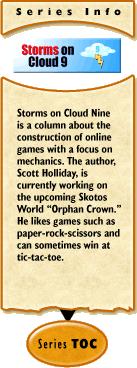 Storms on Cloud 9 #28:
Storms on Cloud 9 #28:
Keeping it Together
by Scott Holliday
2004-03-26
There's nothing quite like playing someone else's game to make you take an honestly brutal look at what you are building yourself. This time around, I've been trying out a MMOG with hundreds of players - but no community to speak of. In other words, they've built an interesting game with good marketing and a natural attraction to players (such as myself), but nobody is connecting with each other. With all those players, I often notice that every single one is playing by themselves. This defeats the advantages and the purpose of playing a game online. Considering critical mass and related concepts (TT&T#143), I wonder where the game would be if the links between players were stronger.
So why is player interaction so poor? What could be done to improve it? These questions carry across the entire online genre. Even games that are working very well should be asking themselves how they could be better. And in every case that I've seen, I think it can be summarized down to three words: "don't split players."
Consider the basic design of an online game. Do all of your players interact regularly? Or would they be just as happy on ten smaller servers? These are important questions, because if your players are split into small groups, you've just raised the bar for critical mass - each group needs its own host of players to be functional.
- Levels: So you decided to use level-based advancement? Why? You've just splintered your community into a number of sub-groups equal to the number of experience levels available. Although there will be some overlap, generally most players will only interact with players around their own level. I imagine most of you have experienced this issue when you make friends with other players, but you (or they) level too fast. You can't really hang out together anymore - at least not while playing the game as designed. This is also exactly the reason why many older games die. New players enter, but all the other players might as well be on another server. The two groups are effectively invisible to each other. The new players leave in despair - leaving the same problem for the next batch of newbies… total newbie churn.
- Goals: How many teams do you have? Assuming just good and evil, you've just divided your community in half. Admittedly, they might still see each other, but only in a confrontational basis. Even this confrontation will lack the involvement of a true Nemesis-style enmity; who wants to waste time flinging insults or plotting when they could be attacking? And what happens when almost everyone decides to play evil? Now you have a very lopsided community, making the good team even less appetizing.
- Differences: Much like teams, there are a variety of other factors that can split your players. Do all the player races/classes get along? Yep, that's right, more divisions. Worse, how many of the same esoteric class are useful to the party? Should players expect to get to know many of their own specialties?
- Guilds: Generally speaking, guilds are a good thing. They often increase player involvement tremendously. However, these are often formed from OOC relationships. This leaves the remainder as loners and loose-knit temporary organizations. Likewise, what does a new loner think when entering the game? Probably, he feels like an outsider looking in. Assuming he musters the effort to get involved, will guilds take him with no qualifications and no questions asked?
- Interests: Do the different gaming interest groups work well together? We all know Bartle's classifications. However, do they need each other? Do explorers make good teammates for achievers? Is there any reason for a killer to take along a socializer (other than to murder them)? Assuming the answer is "no", your community is split even further.
So counting divisions - let's look at an example: 50 levels, 2 opposing goals, all races/classes interact, only need one of each of the 4 specializations in a party, players make guilds freely, only counting 4 major interests (and all those between). So, by a low estimate : ~10 * 2 * 1 * ~1.5 * ~2 * 4 = 240 splits! Do you have less than 240 players? Now you know why most of them are all doing the same thing, are off by themselves, or worse… they come, they see, they leave.
Next time, I'll try to address each of these divisions and look at ways to remove or reduce the effect. Some solutions are already pretty standard. For others, many solutions have been proposed and attempted, and the latest iterations are still in the testing stages - so you'll need to keep your eyes open.
[ <— #27: Tantalizing Choices | #29: Splinter Bonding —> ]

